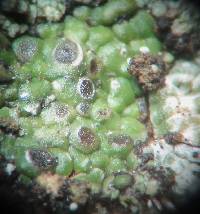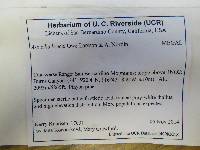
Consortium of Lichen Herbaria
- building a Global Consortium of Bryophytes and Lichens as keystones of cryptobiotic communities -
- Home
- Search
- Images
- Species Checklists
- US States: O-Z >
- US National Parks
- Central America
- South America
- US National Parks
- Southern Subpolar Region
|
|
|
|
Family: Megasporaceae
|
Nash, T.H., Ryan, B.D., Gries, C., Bungartz, F., (eds.) 2007. Lichen Flora of the Greater Sonoran Desert Region. Vol 3. Thallus: areolate, 1.5-8 cm in diam., (0.1-)0.2-0.5(-1) mm thick areoles: angular, rarely irregular, flat to sometimes convex or concave, (0.2-)0.4-1(-2) mm in diam., contiguous, separated by narrow cracks prothallus: usually absent, sometimes present as a narrow zone at the thallus edge, black, 0.1-0.2 mm wide surface: gray to gray-white, sometimes with a greenish tinge, rarely partly ochre or brown-gray to brown, dull to slightly shiny upper cortex: (15-)20-35 µm thick, uppermost part usually ±brown, 5-10(-15) µm thick, with cells 5-7 µm in diam.; cortex covered with an epinecral layer 2-11 µm thick photobiont: chlorococcoid, cells ±round, 5-17 µm in diam Apothecia: aspicilioid, usually rather common, (0.1-)0.2-0.4(-0.5) mm in diam., 1-2(-3) per areole, round to angular, sometimes linear disc: black or brown-black, ±shiny, concave, sometimes plane, rarely convex, without pruina thalline margin: thin, flat to slightly raised, rarely prominent, often forming a thin, white rim around the disc, or concolorous with thallus exciple: (15-)20-40(-50) µm wide, I+ blue or partly I-, uppermost cells brown to green-brown, ±globose, 4-5(-6) µm in diam. epihymenium: green to olive, olive-brown or brown, without or with a few crystals, N+ green to blue-green, K+ brown hymenium: hyaline, I+ persistently blue or partly turning blue-green to yellow-green or copper-red, (70-)90-120(-130) µm tall paraphyses: non-moniliform (upper cells cylindrical, not or slightly constricted at septa) to submoniliform, with 0-2(-3) upper cells ±globose, uppermost cells (2.5-)3-4 µm wide, in lower part (1-)1.5-2 µm wide, slightly branched and anastomosing subhymenium and hypothecium: pale, I+ persistently blue, together 40-60(-80) µm thick asci: clavate, (40-)50-65(-70) x 12-17 µm, 8-spored ascospores: hyaline, simple, ellipsoid, rarely subglobose, (9-)10-13 x 5-8(-11) µm Pycnidia: rare to rather common, 1-2(-4) per areole, immersed, rarely with a white rim, rarely aggregated, 110-250 µm in diam., with a black, punctiform to rarely elongated ostiole, 50-100(-120) µm in diam conidia: short, filiform, (5-)6-10(-11) x 0.8-1.5 µm Spot tests: cortex and medulla I-, K+ red, P+ orange, C- Secondary metabolites: norstictic acid, sometimes also with connorstictic acid and hyposalazinic acid in addition (4 specimens: Owe-Larsson 9147; Ryan 24214 & 25820; Wetmore 51159). Substrate and ecology: on siliceous rock or basalt, often in forests and ±shaded World and Sonoran distribution: southern California (Riverside, San Diego, Tulare and Tuolumne Counties), and Guadalupe Island (Baja California, Mexico), at 1250-1810 m. Notes: Aspicilia brucei is characterized by its gray to gray-white thallus, its small apothecia, its short hymenium with non-moniliform to submoniliform paraphyses and small spores, its short conidia and the presence of norstictic acid and sometimes hyposalazinic acid. Aspicilia brucei might superficially resemble Aspicilia cinerea or A. pacifica, but those species have longer conidia and larger spores. Other species with short conidia and norstictic acid in the area are Aspicilia aurantiaca, A. knudsenii and A. sipeana. They all have taller hymeniums and larger spores. The first two also have different thallus colors, and A. sipeana has ±dispersed areoles. DNA (ITS) has been analyzed in two specimens, including the type (Owe-Larsson 9147 & 9161). |
|
|
|
Powered by Symbiota





















